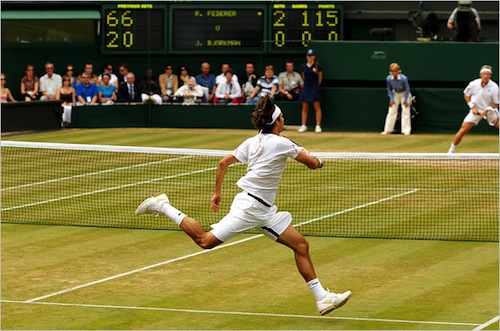
Image Credit: New York Times
This might be my last viz. post for the year, and so I thought I’d take a moment and say something that I’ve been dying to say for about 18 months or so: David Foster Wallace’s “Federer as Religious Experience” (New York Times Magazine, August 2006) is an allegory for what Wallace thinks fiction can (and should) be after postmodernism. Please forgive me if any of this seems obvious. In early July of 2006 Wallace headed over to south-west London to take in Wimbledon for the Times. Ostensibly, the magazine piece that resulted was a long definition of Rodger Federer’s talents as a tennis player. Wallace’s argument turned out to be that “if you’ve never seen the young man play live, and then do, in person, on the sacred grass of Wimbledon…then you are apt to have what one of the tournament’s press bus drivers describes as a ‘bloody near-religious experience.’” Religious sentiments are present throughout the article, and Wallace works hard to articulate the ways in which perfect beauty can be found at the highest level of sport. It all has to do with “human beings’ reconciliation with the fact of having a body,” Wallace suggests. To parse this out, Wallace explains the evolution of professional tennis tactics since the days of Jimmy Connors.
Recent comments
2 years 29 weeks ago
2 years 44 weeks ago
2 years 44 weeks ago
2 years 50 weeks ago
3 years 4 weeks ago
3 years 4 weeks ago
3 years 4 weeks ago
3 years 6 weeks ago
3 years 6 weeks ago
3 years 6 weeks ago